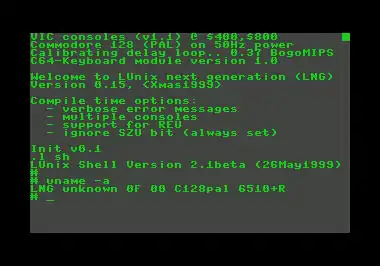 | |
| Written in | Assembly language |
|---|---|
| OS family | Unix-like |
| Working state | Historic |
| Latest release | 0.21 |
| Platforms | C64, C128 |
| Default user interface | CLI |
| License | GNU General Public License |
| Official website | lng |
LUnix (short for "Little Unix")[1] is a Unix-like multi-tasking operating system designed to run natively on the Commodore 64 and Commodore 128[2] home computer systems. It supports TCP/IP networking (SLIP or PPP using an RS-232 interface). Unlike most Unix-like systems, LUnix is written in 6502 assembly language instead of C.
The first version of LUnix was released in 1993; the current version 0.21 dates from 2004. Amongst others, it supports preemptive multitasking, Unix pipes, a variety of protocols like TCP/IP, SLIP, PPP and RS-232, dynamic memory management and virtual consoles. It contains a web server and clients for telnet, POP3 and FTP and can act as a terminal or terminal server over RS-232.
LUnix was developed by Daniel Dallmann and contributed by Ilker Ficicilar, Stefan Haubenthal, Maciej Witkowiak and Paul Gardner-Stephen in late 1990s. The first generation LUnix had support for faster RS-232 via clever software tricks, 80 column VIC and VDC screen support, PS/2 keyboard support, and small set of standard Unix commands. It is possible with this first distribution to attach two keyboards and two monitors and one RS-232 terminal to set up a three simultaneous, multitasking sessions on a C128. LUnix also supports 2 MHz mode and boot disk convenience of C128 platform.
LUnix came with an extensive documentation at the time. Well-defined library calls, relocatable code support and decent memory management functions made it possible to develop software for LUnix easily.
See also
References
- ↑ "About LUnix" Archived 2010-08-23 at the Wayback Machine, retrieved on 2010-08-27
- ↑ "LUnix Sourceforge Homepage", Retrieved on 2010-08-28